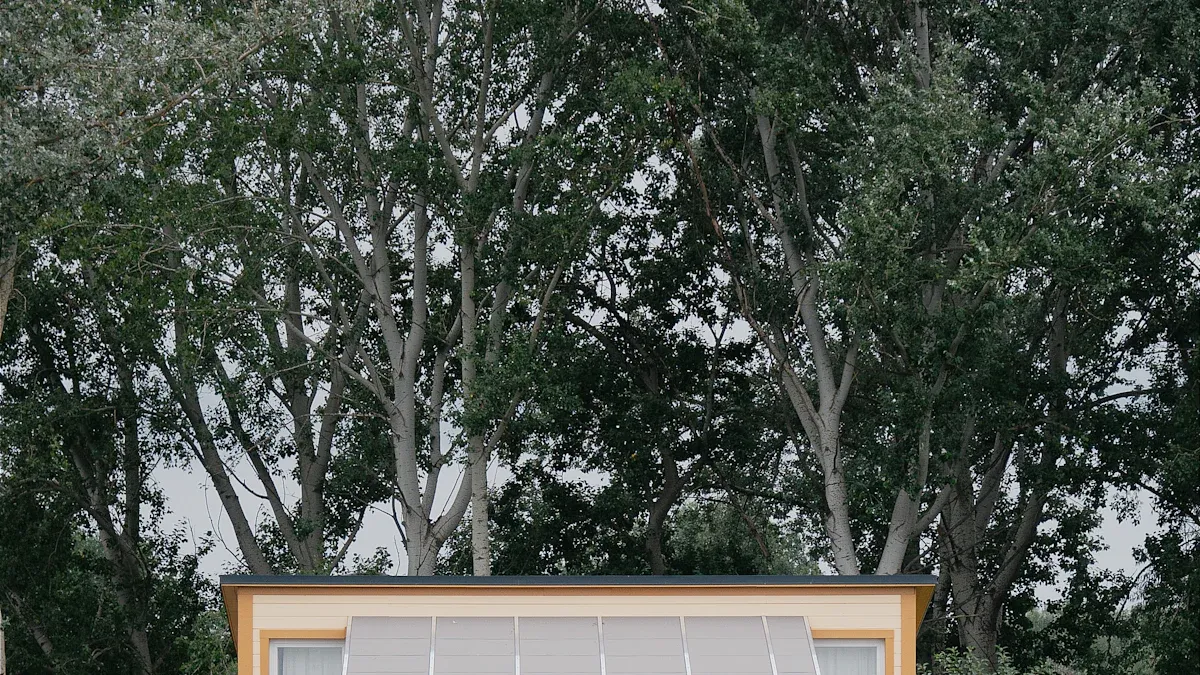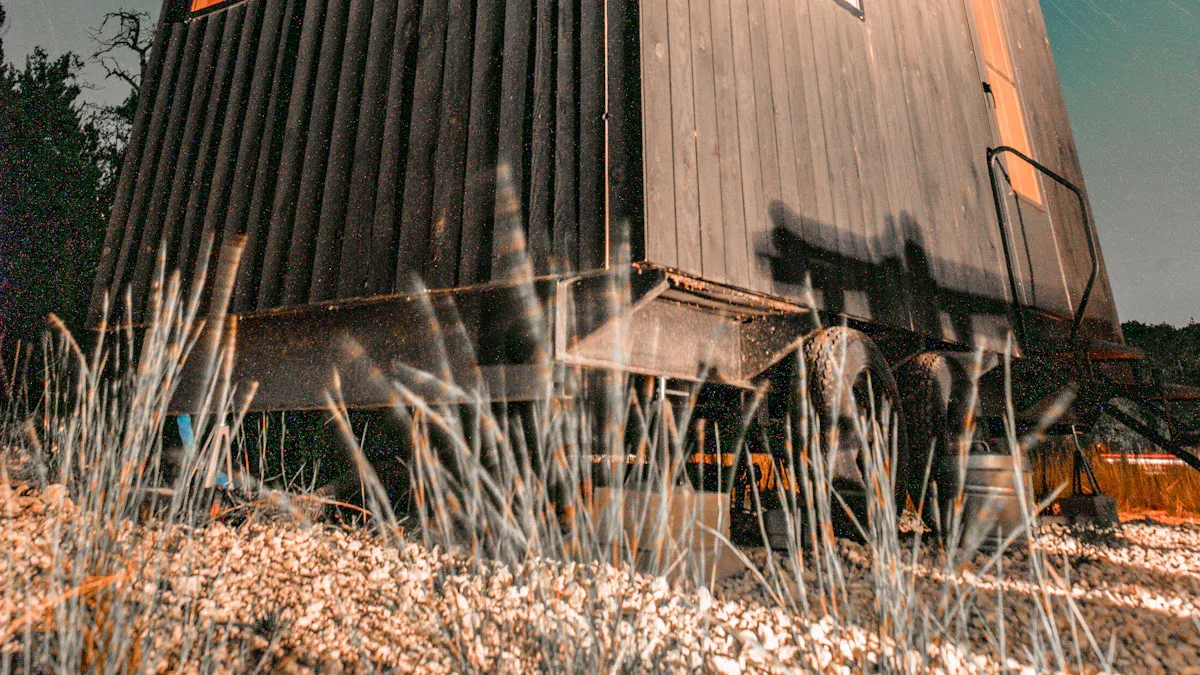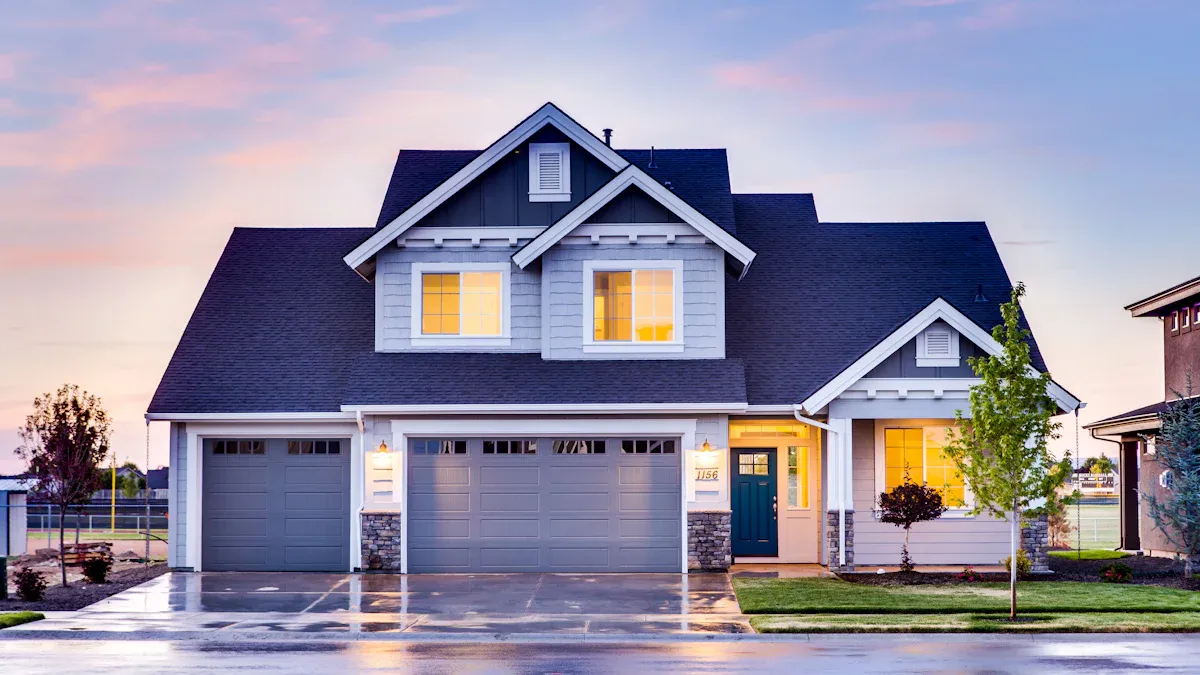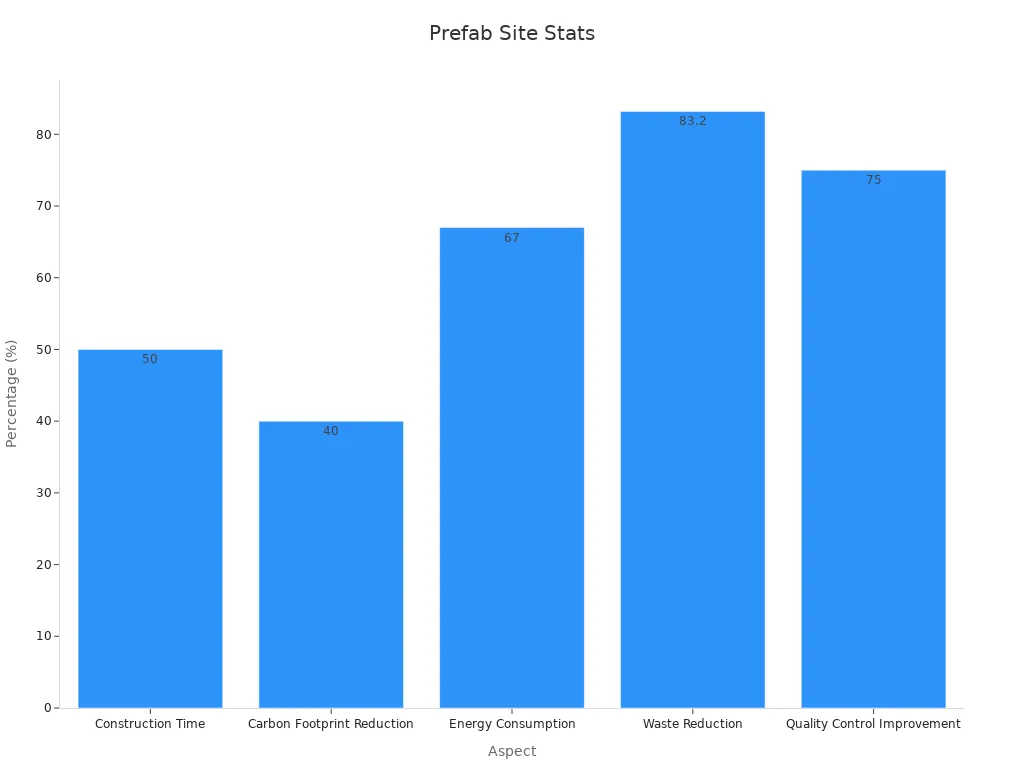
Prefab houses are transforming the housing market in 2025. They’re not just homes; they’re a smarter, greener way to live. These homes can reduce construction waste by up to 90%, making them a sustainable choice. Plus, they’re up to 20% cheaper than traditional homes, offering affordable prefab housing for families. With energy-efficient designs saving over 30% on energy costs, they’re perfect for modern living. Imagine stepping into a space capsule of innovation, where every detail is tailored to your needs. Prefab houses combine affordability, efficiency, and customization like never before.
Understanding Prefab Houses

What Is a Prefab House
A prefab house, short for prefabricated house, is a home built off-site in a controlled factory environment. Instead of constructing the house entirely on the property, manufacturers assemble sections or modules in a factory and then transport them to the site for final assembly. This process ensures precision and reduces construction time significantly.
Prefab houses are designed to meet modern housing needs. They offer cost efficiency, sustainability, and customization. Urbanization and the growing demand for scalable housing solutions have made prefab homes a popular choice. Technological advancements have also improved their quality and durability, aligning with consumer preferences for eco-friendly living.
Types of Prefab Houses
Prefab houses come in various types, each catering to different needs and budgets. Here’s a breakdown:
- Modular Homes: Built in sections (modules) and assembled on-site. They use materials like wood, concrete, and steel.
- Panelized Homes: Pre-assembled panels are transported and put together on-site. These are often made of wood.
- Pre-cut Homes: Materials are pre-measured and cut for assembly, ideal for DIY enthusiasts.
- Manufactured Homes: Fully constructed in a factory and transported as a single unit.
- Others: Include composite structures and hybrid designs for specialized applications.
| Type of Prefab House | Material Used | Application |
|---|---|---|
| Modular Homes | Wood, Concrete, Steel | Residential, Commercial, Industrial |
| Panelized Homes | Wood | Residential |
| Pre-cut Homes | Wood | Residential |
| Manufactured Homes | Various Materials | Residential |
| Others | Various Materials | Various Applications |
Modular vs. Manufactured vs. Kit Homes
Choosing between modular, manufactured, and kit homes depends on your priorities. Modular homes are built in sections and cost around $165 per square foot, making them more affordable than traditional homes, which average $400 per square foot. They also take just a few months to complete. Manufactured homes, on the other hand, are fully built in factories and transported as a single unit. Kit homes are pre-cut and designed for DIY assembly, offering flexibility for hands-on homeowners.
Nearly 20% of new modular homes sell for less than $300,000, compared to 14.2% of stick-built homes. While modular homes are gaining popularity, manufactured homes remain a budget-friendly option. Kit homes appeal to those who enjoy customization and hands-on projects.
Benefits and Drawbacks of Prefab Houses
Advantages of Prefab Houses
Prefab houses offer a range of benefits that make them an attractive choice for modern homeowners. One of the biggest advantages is cost savings. Prefabricated homes can be built for up to 50% less than traditional site-built homes. Labor costs are also significantly lower, accounting for only 8-12% of the total cost compared to 40-60% for conventional construction. Manufacturers save up to 30% on materials by purchasing in bulk, which helps keep prices affordable for buyers.
Another major benefit is waste reduction. Prefab construction can reduce waste by as much as 90%, making it an eco-friendly option. These homes are also energy-efficient, with designs that can save homeowners 30% or more on energy bills. Additionally, prefab houses are often 20-40% cheaper than traditional homes, making them a budget-friendly option for families.
| Benefit | Numerical Evidence |
|---|---|
| Cost Savings | Up to 50% cheaper than site-built homes |
| Labor Cost | 8-12% of total cost (vs. 40-60% for traditional homes) |
| Material Cost Savings | Up to 30% savings through bulk purchasing |
| Waste Reduction | Up to 90% less construction waste |
| Energy Efficiency | 30% or more energy savings |
Prefab houses also cater to modern lifestyles. Over 70% of homebuyers express interest in smart home features, which are often integrated into prefab designs. These homes combine affordability, sustainability, and innovation, making them a smart choice for 2025.
Challenges to Consider
While prefab houses have many advantages, there are some challenges to keep in mind. One common issue is the perception of quality. Some people believe prefab homes are less durable than traditional houses, even though modern designs often prove otherwise. Zoning regulations and building codes can also complicate the process. These rules vary widely across states and municipalities, making it essential to research local requirements before purchasing.
Financing can be another hurdle. Banks and lenders sometimes hesitate to provide loans for prefab homes, and appraisals can be tricky. Additionally, there’s a shortage of skilled workers trained in prefab construction techniques, which can lead to delays or higher costs in some areas.
- Key Challenges:
- Negative perceptions about quality and durability.
- Complex zoning regulations and building codes.
- Difficulty obtaining financing and appraisals.
- Shortages of skilled prefab construction workers.
Despite these challenges, the benefits of prefab houses often outweigh the drawbacks. With proper planning and research, buyers can navigate these obstacles and enjoy the many advantages of prefab living.
Step-by-Step Guide to Buying a Prefab House

Setting Your Budget
Before diving into the world of prefab houses, it’s essential to set a clear budget. Start by considering the total cost, including the house itself, site preparation, and installation. Prefab homes often save money due to streamlined processes and bulk material purchases. For example, the prefab housing market is projected to grow at a 5.8% CAGR from 2024 to 2033, driven by cost efficiency and technological advancements like Building Information Modeling (BIM). These innovations reduce errors and speed up timelines, saving you money in the long run.
| Financial Data and Budgeting Methods | Details |
|---|---|
| Market Size (2024) | USD 36,139.5 Million |
| Projected Market Size (2033) | USD 60,027.9 Million |
| Cost Efficiency | Significant savings |
| Government Incentives | Support for green housing |
Choosing the Right Design
Design is where your prefab house becomes uniquely yours. Modern prefab homes offer endless customization options, from layouts to smart home features. Consumers increasingly demand homes that reflect their personal style and functional needs. Modular designs allow for easy modifications, making it simple to adapt your home to your lifestyle. Whether you want an open floor plan or energy-efficient windows, prefab manufacturers can deliver.
Understanding Costs and Financing
Financing a prefab house can differ from traditional homes. Costs typically include the prefab service, local installation, and additional site work. For instance, a typical prefab project might break down as follows:
| Cost Component | Amount |
|---|---|
| Eko Prefab Service | $65,360 |
| Prefab Local Install | $40,850 |
| PREFAB TOTAL | $106,210 |
Shorter build times can also reduce rental costs during construction. Many lenders now offer prefab-specific loans, so explore your options to find the best rates.
Selecting a Manufacturer
Choosing the right manufacturer is crucial. Look for companies with high customer satisfaction scores and low defect rates. For example, a defect rate below 2% and satisfaction scores above 80% indicate excellent quality. Ningbo Cheerme Intelligent Furniture Co., Ltd. is a standout in the industry, offering modular designs with a focus on sustainability and user experience.
Preparing the Site
Site preparation is a critical step. A well-prepared site ensures smooth installation and reduces delays. Prefab construction can cut waste by up to 83.2% and lower energy consumption by 67%. Ensure the site is level, accessible, and compliant with local zoning laws.

Installation and Finalization
The final step is installation. This involves assembling the prefab components, adding finishing touches like windows and doors, and conducting quality checks. Depending on the complexity, this phase can take a few weeks to several months. Once complete, you’ll receive your dream prefab house, ready to move in!
Key Considerations for Choosing a Prefab House
Energy Efficiency and Sustainability
Energy efficiency and sustainability are top priorities for many buyers in 2025. Prefab houses excel in these areas, offering significant environmental benefits. For instance, modular construction can reduce overall waste by up to 83.2% and lower energy consumption by 67%. These homes also cut the carbon footprint by as much as 40%, making them a greener choice compared to traditional builds.
Many prefab designs incorporate renewable energy systems like solar panels and energy-efficient materials. This not only reduces utility bills but also aligns with global efforts to achieve carbon neutrality. Buyers should look for homes that meet these standards to maximize long-term savings and environmental impact.

Customization and Design Options
Modern prefab houses offer endless customization possibilities. Buyers can choose from various layouts, materials, and finishes to create a home that reflects their style. Technological advancements like Building Information Modeling (BIM) have made it easier to personalize designs while maintaining efficiency.
Market research shows that consumers increasingly prefer homes with energy-efficient features and personalized layouts. Whether it’s an open floor plan or smart home integration, prefab manufacturers cater to diverse preferences. This flexibility ensures that every buyer can find a design that fits their lifestyle.
Evaluating Manufacturer Reputation
Choosing the right manufacturer is crucial for a successful prefab house purchase. Buyers should prioritize companies with a proven track record of quality and customer satisfaction. Look for manufacturers with defect rates below 2% and satisfaction scores above 80%.
Ningbo Cheerme Intelligent Furniture Co., Ltd. stands out as a leader in the industry. With a focus on modular design and sustainability, they deliver high-performance homes that meet modern needs. Their commitment to innovation and user experience makes them a reliable choice for buyers.
Warranty and After-Sales Support
A strong warranty and reliable after-sales support are essential when investing in a prefab house. Warranties protect buyers from unexpected issues, covering structural components and materials for several years. After-sales support ensures that any problems are resolved quickly, providing peace of mind.
Buyers should review warranty terms carefully and choose manufacturers known for excellent customer service. This ensures a smooth experience from installation to long-term maintenance.
Prefab houses offer a winning combination of affordability, sustainability, and modern design. They save money, reduce waste, and provide endless customization options. Why not explore this innovative housing solution?
🏡 Tip: A prefab home isn’t just a house—it’s a smart investment in your future and the planet.
Ready to make the leap?
FAQ
What is the average cost of a prefab home in 2025?
The average prefab home costs between $100,000 and $300,000, depending on size, materials, and customization. Modular homes typically cost around $165 per square foot.
💡 Tip: Always include site preparation and installation costs in your budget!
How long does it take to build and install a prefab house?
Prefab homes usually take 3-6 months from design to move-in. Factory construction speeds up the process, while site preparation and installation add a few weeks.
Can prefab homes be customized to fit my style?
Absolutely! Prefab homes offer endless customization options, from layouts to finishes. Manufacturers use advanced tools like BIM to create designs that match your preferences and lifestyle.
🛠️ Note: Discuss your ideas with the manufacturer early to ensure feasibility.

